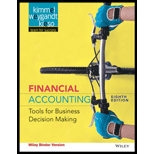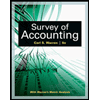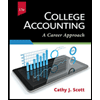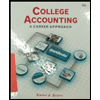
Concept explainers
(a)
To prepare: Bank reconciliation of Company H, as at September 30, 2017
(a)
Answer to Problem 7.9E
Explanation of Solution
Bank reconciliation: Bank statement is prepared by bank. The company maintains its own records from its perspective. This is why the cash balance per bank and cash balance per books seldom agree. Bank reconciliation is the statement prepared by company to remove the differences and disagreement between cash balance per bank and cash balance per books.
Prepare bank reconciliation of Company H, as at September 30, 2017.
| Company H | ||
| Bank Reconciliation | ||
| September 30, 2017 | ||
| Cash balance as per bank statement, September 30, 2017 | $16,500 | |
| Add: Deposits in transit | 4,738 | |
| 21,238 | ||
| Less: Outstanding checks | 2,383 | |
| Adjusted cash balance per bank | $18,855 | |
| Cash balance as per books, September 30, 2017 | $17,600 | |
| Add: Note receivable collected by bank | $1,830 | |
| Interest earned on checking account | 45 | 1,875 |
| 19,475 | ||
| Less: NSF check | 560 | |
| Safety deposit box rent | 60 | 620 |
| Adjusted cash balance per books | $18,855 | |
Table (1)
- The deposits which are not recorded by the bank are referred to as deposits in transit. Since the deposits in transit are not reflected on the bank statement, the company should add deposits in transit to cash balance per bank, while preparation of
bank reconciliation statement . - Outstanding checks are the checks that are issued by the company, but not yet paid by the bank. When the check is issued for payment, the company deducts the cash balance immediately. But the bank deducts only when the cash is paid for the issued check. So, company deducts the cash balance per bank to remove the differences.
- Note receivable being collected by bank, is credited to bank account. But the company is not aware of it. So, while preparing bank reconciliation statement, company should add the amount to the cash balance per books.
- Interest earned on checking account is credited by bank to the bank account of which the company is not aware of. So, while preparing bank reconciliation statement, company should add the amount to the cash balance per books.
- While bank reconciliation, the NSF check should be deducted from the cash balance per book. This is because the bank could not collect funds from the customer’s bank due to lack of funds. But being recorded as
Accounts Receivable previously, the balance should be deducted from books, to increase the Accounts Receivable account. - Banks deduct the service charge for the services rendered like lock box rental, or printed checks. But the company is not aware of such deductions. So, company deducts the cash balance per books while bank reconciliation preparation.
(b)
To prepare:
(b)
Explanation of Solution
Journal entry:
Debit and credit rules:
- Debit an increase in asset account, increase in expense account, decrease in liability account, and decrease in
stockholders’ equity accounts. - Credit decrease in asset account, increase in revenue account, increase in liability account, and increase in stockholders’ equity accounts.
Prepare journal entry to record note receivable collected by bank.
| Date | Account Titles and Explanation | Ref. | Debit ($) | Credit ($) | |
| 2017 | |||||
| September | 30 | Cash | 1,830 | ||
| Note Receivable | 1,830 | ||||
| (To record receivable collected by bank) | |||||
Table (2)
Explanation:
- Cash is an asset account. The amount is increased because bank collected note receivable, and an increase in assets should be debited.
- Note Receivable is an asset account. The amount has decreased because the amount to be received is collected by the bank, and, a decrease in assets should be credited.
Prepare journal entry to record interest revenue.
| Date | Account Titles and Explanation | Ref. | Debit ($) | Credit ($) | |
| 2017 | |||||
| September | 30 | Cash | 45 | ||
| Interest Revenue | 45 | ||||
| (To record interest received) | |||||
Table (3)
Explanation:
- Cash is an asset account. The amount is increased because bank collected note receivable, and an increase in assets should be debited.
- Interest Revenue is a revenue account. The amount has increased because interest is earned. Revenues increase Equity account, and an increase in Equity is credited.
Prepare journal entry to record NSF check.
| Date | Accounts and Explanation | Post Ref. | Debit ($) | Credit ($) | |
| 2017 | |||||
| September | 30 | Accounts Receivable (A+) | 560 | ||
| Cash (A–) | 560 | ||||
| (To record NSF check) | |||||
Table (4)
Explanation:
- Accounts Receivable is an asset account. The bank has not collected the amount from the customer due to insufficient funds, which was earlier recorded as a receipt. As the collection could not be made, amount to be received increased. Therefore, increase in asset would be debited.
- Cash is an asset account. The amount is decreased because bank could not collect amount due to insufficient funds in customer’s account, and a decrease in asset is credited.
Prepare journal entry to record bank service charge.
| Date | Account Titles and Explanation | Ref. | Debit ($) | Credit ($) | |
| 2017 | |||||
| September | 30 | Bank Charge Expense | 60 | ||
| Cash | 60 | ||||
| (To record safety deposit box rent) | |||||
Table (5)
Explanation:
- Bank Charges Expense is an expense account and the amount is increased because bank has charged service charges. Expenses decrease Equity account and decrease in Equity is debited.
- Cash is an asset account. The amount is decreased because bank service charge is paid, and a decrease in asset is credited.
Want to see more full solutions like this?
Chapter 7 Solutions
Financial Accounting 8th Edition
- i need correct optionarrow_forwardMark purchased 200 shares of stock for $40 per share. During the year, he received $500 in dividends. He recently sold the stock for $55 per share. What was Mark's return on the stock? a) $3,500 b) $4,000 c) $3,900 d) $4,500arrow_forwardSummit Industries has a normal capacity of 30,000 direct labor hours. The company's variable costs are $42,000, and its fixed costs are $18,000 when running at normal capacity. What is the standard manufacturing overhead rate per unit? a) $1.50 b) $1.60 c) $2.00 d) $2.10arrow_forward
- Ivanhoe, Inc. has recently started the manufacture of Tri-Robo, a three-wheeled robot that can scan a home for fires and gas leaks and then transmit this information to a smartphone. The cost structure to manufacture 20,400 Tri-Robos is as follows. Cost Direct materials ($51 per robot) $1,040,400 Direct labor ($39 per robot) 795,600 Variable overhead ($7 per robot) 142,800 Allocated fixed overhead ($29 per robot) 591,600 Total $2,570,400 Ivanhoe is approached by Tienh Inc., which offers to make Tri-Robo for $116 per unit or $2,366,400. Following are independent assumptions. Assume that none of the fixed overhead can be avoided. However, if the robots are purchased from Tienh Inc., Ivanhoe can use the released productive resources to generate additional income of $375,000. (Enter negative amounts using either a negative sign preceding the number e.g. -45 or parentheses e.g. (45).) Direct materials Direct labor Variable overhead Fixed overhead Opportunity cost Purchase price Totals Make…arrow_forwardcorrect answer pleasearrow_forwardcost accountingarrow_forward
- Summit Holdings has $280,000 in accounts receivable that will be collected within 70 days. The company needs cash urgently and decides to factor them, receiving $260,000. Skyline Factoring Company, which took the receivables, collected $275,000 after 85 days. Find the rate of return on this investment for Skyline.arrow_forwardwhat are the variable expenses per unit?arrow_forwardprice-earning ratio accounting questionarrow_forward
 Financial And Managerial AccountingAccountingISBN:9781337902663Author:WARREN, Carl S.Publisher:Cengage Learning,Century 21 Accounting Multicolumn JournalAccountingISBN:9781337679503Author:GilbertsonPublisher:Cengage
Financial And Managerial AccountingAccountingISBN:9781337902663Author:WARREN, Carl S.Publisher:Cengage Learning,Century 21 Accounting Multicolumn JournalAccountingISBN:9781337679503Author:GilbertsonPublisher:Cengage Survey of Accounting (Accounting I)AccountingISBN:9781305961883Author:Carl WarrenPublisher:Cengage Learning
Survey of Accounting (Accounting I)AccountingISBN:9781305961883Author:Carl WarrenPublisher:Cengage Learning College Accounting (Book Only): A Career ApproachAccountingISBN:9781337280570Author:Scott, Cathy J.Publisher:South-Western College Pub
College Accounting (Book Only): A Career ApproachAccountingISBN:9781337280570Author:Scott, Cathy J.Publisher:South-Western College Pub College Accounting (Book Only): A Career ApproachAccountingISBN:9781305084087Author:Cathy J. ScottPublisher:Cengage Learning
College Accounting (Book Only): A Career ApproachAccountingISBN:9781305084087Author:Cathy J. ScottPublisher:Cengage Learning





